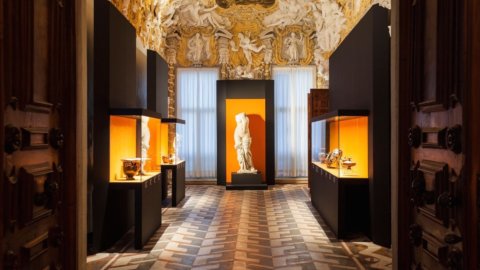The exhibition La seduction opens today at the Gallerie d'Italia – Palazzo Leoni Montanari, the museum and cultural headquarters of Intesa Sanpaolo in Vicenza. Myth and art in ancient Greece, new edition of the review Il Tempo dell'Antico. Attic and Magna Graecia ceramics from the Intesa Sanpaolo collection, the exhibition project dedicated to enhancing the Intesa Sanpaolo collection of Attic and Magna Graecia ceramics.
The exhibition, curated by the archaeologist Federica Giacobello and created in collaboration with the National Archaeological Museum of Naples and the National Archaeological Museum of Reggio Calabria, investigates the forms and images of seduction in ancient Greece, evoking that dimension of love so strongly present in Greek world, documented by art and literature, well expressed by the passionate verses of Sappho's poetry and even earlier by the Homeric poems, testified by mythical figures and tales.
Michele Coppola, Intesa Sanpaolo Central Director of Art, Culture and Historic Heritage comments: "The new appointment of the Tempo dell'Antico renews the Bank's commitment to enhancing its artistic heritage and confirms the dialogue and collaboration with two important Italian companies, the Archaeological Museums of Naples and Reggio Calabria. Thanks to an original exhibition that explores the theme of seduction starting from the vases in the Intesa Sanpaolo collection, the Gallerie d'Italia and Progetto Cultura demonstrate once again that they know how to establish themselves as a place to promote the Italian cultural identity and tradition."
Seduction induces love by bewitching and deceiving the minds and senses of man and is achieved through the sharing of different sensory dimensions: the beauty of bodies, clothes and jewels, perfume and persuasive words. The experience of love in Greek culture is considered strongly imbued with religiosity placed under the aegis of Aphrodite, the seductive goddess par excellence. The first section of the exhibition is dedicated to her and to Eros in which, through the representations of the vases and three statuary specimens from the National Archaeological Museum of Naples, the personality of these divinities and the cult dedicated to them will be traced.
One of the greatest seducers that the Greek myth has given us back is Elena of Sparta (second section of the exhibition), capable of bewitching and captivating princes and heroes with her proverbial beauty. About her Her story and her seductive power are investigated starting from the crater of Intesa Sanpaolo which portrays her together with the Dioscuri brothers, and from a loutrophoros, a vascular form linked to marriage and the female world, from the National Archaeological Museum of Naples . At the same time, the personality of the seductive males is traced, who in the Greek mentality are at the antipodes of the valiant warrior heroes.
From gods and myths we then move on to men: the dynamics of seduction are investigated, achieved through beauty - obtained with careful preparation, choice of clothes, hairstyles and jewels - the exchange of glances and gestures, fleeting encounters . Vascular shapes intended to contain oils, ointments, cosmetics and make-up objects together with extraordinary bronze mirrors from the National Archaeological Museum of Reggio Calabria, functional tools for women's 'making themselves beautiful' and with a strong symbolic value close the visit to the forty-two works on display. Numerous side activities to explore the themes of the exhibition, enriched by multimedia content and an olfactory journey.
The exhibition project called Il Tempo dell'Antico. Attic and Magna Graecia ceramics from the Intesa Sanpaolo collection is dedicated to enhancing and sharing the important Intesa Sanpaolo collection with the community and presents nuclei of vases selected on a thematic basis from the collection on a rotating basis. The historic Caputi collection, whose formation dates back to the first half of the 522th century, consists of a large corpus of XNUMX finds from the grave goods of Ruvo di Puglia, a thriving ancient center in the current province of Bari. The painted vases, which in together they provide a significant testimony of the culture and art of Western Greece, they were produced between the XNUMXth and XNUMXrd centuries BC in the ceramic workshops of Apulia and Lucania or imported from Athens. The catalog is published by Marsilio Editori.





